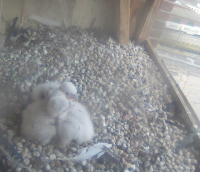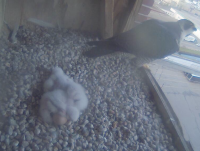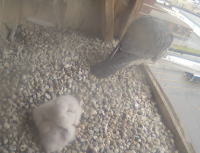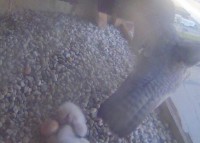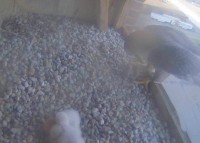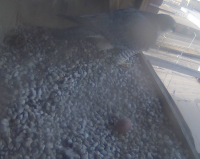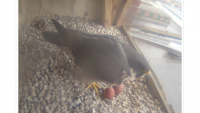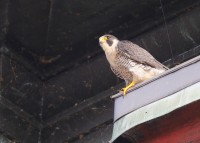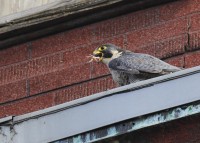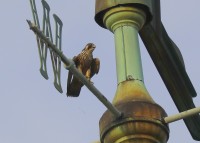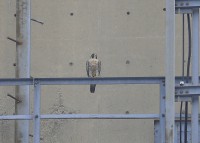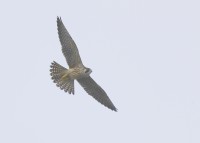Lawrence Peregrines: adult food transfer
May 16, 2019 in In the Nest Box, lawrence peregrines, On the Clock Tower
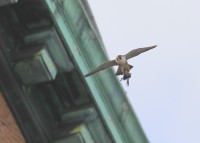 Made a stop by the Clock Tower around 5:15PM this afternoon under overcast skies, wind from SE at 6MPH, and temp at 64F. Upon arrival, the female was seen out of the nest box and making a number of circles around the Clock Tower. She finally settled on an upper edge on the NW corner. As I scanned all over to see if the male was around, airborne feathers started to float by above the west clock face. Well that usually means one thing! The male was ripping apart fresh caught prey and preparing the next meal. Once the prep work was finished, he launched into flight, initially swooping downwards, and then around the corner and to the NW.
Made a stop by the Clock Tower around 5:15PM this afternoon under overcast skies, wind from SE at 6MPH, and temp at 64F. Upon arrival, the female was seen out of the nest box and making a number of circles around the Clock Tower. She finally settled on an upper edge on the NW corner. As I scanned all over to see if the male was around, airborne feathers started to float by above the west clock face. Well that usually means one thing! The male was ripping apart fresh caught prey and preparing the next meal. Once the prep work was finished, he launched into flight, initially swooping downwards, and then around the corner and to the NW.
 A few minutes later, while going out of sight, the female swooped in and then made a very nice food transfer. The male continues to do the bulk of the hunting. To feed the chicks, the male will capture prey and prepare it nearby. The male then readies himself for flight and food transfer. the female will receive the fresh pray and return promptly to the nest box to feed the nestlings. Great teamwork!
A few minutes later, while going out of sight, the female swooped in and then made a very nice food transfer. The male continues to do the bulk of the hunting. To feed the chicks, the male will capture prey and prepare it nearby. The male then readies himself for flight and food transfer. the female will receive the fresh pray and return promptly to the nest box to feed the nestlings. Great teamwork!
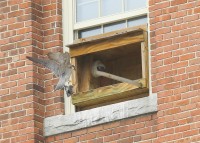 After the female captured the prey with her talon, she returned to the nest box. She arrived and landed on the left side of the window box ledge. In sorting through the photos, it was fascinating to see that as she arrived, the prey was in her left talon, and then in a flash, she moved it to her bill while landing on the outer edge of the box!
After the female captured the prey with her talon, she returned to the nest box. She arrived and landed on the left side of the window box ledge. In sorting through the photos, it was fascinating to see that as she arrived, the prey was in her left talon, and then in a flash, she moved it to her bill while landing on the outer edge of the box!

